Cyber Warfare: Fog of War, Decision Making, and Critical Analysis
VerifiedAdded on 2020/05/11
|10
|2095
|69
Report
AI Summary
This report provides an in-depth analysis of cyber warfare, exploring the concept of the 'Fog of War' and its implications on decision-making processes. It examines the information environment, highlighting the challenges and complexities faced by organizations and governments in the digital age. The report also delves into the application of the 'Multiple Attribute Decision-Making' (MADM) approach in the context of cyber warfare, discussing its strengths and limitations. Furthermore, it offers a critical discussion of the challenges, including the ambiguities and uncertainties inherent in cyber conflicts. The report concludes by emphasizing the importance of understanding and mitigating the 'Fog of War' to improve decision-making and minimize the impact of cyberattacks. It draws on various research papers to support its arguments.
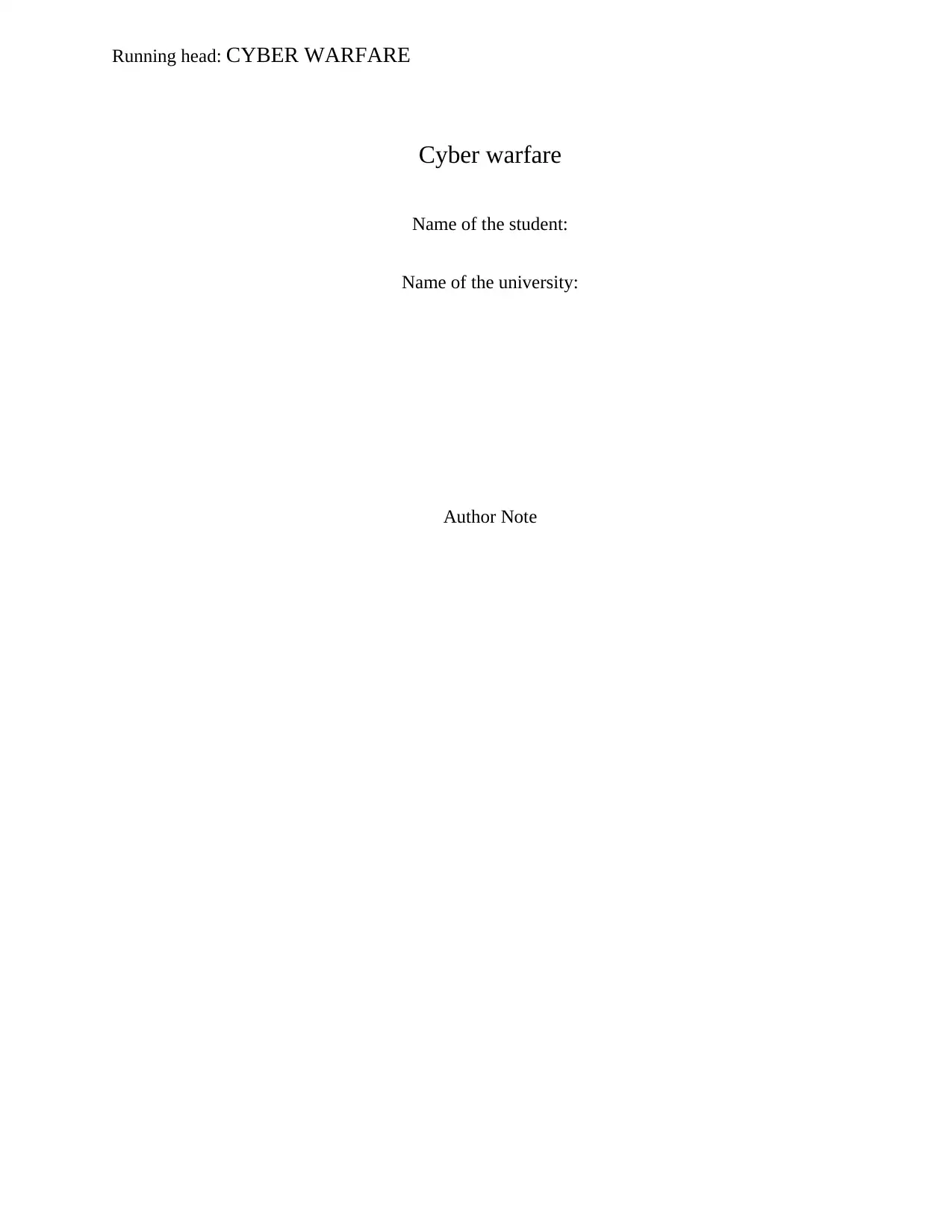
Running head: CYBER WARFARE
Cyber warfare
Name of the student:
Name of the university:
Author Note
Cyber warfare
Name of the student:
Name of the university:
Author Note
Paraphrase This Document
Need a fresh take? Get an instant paraphrase of this document with our AI Paraphraser
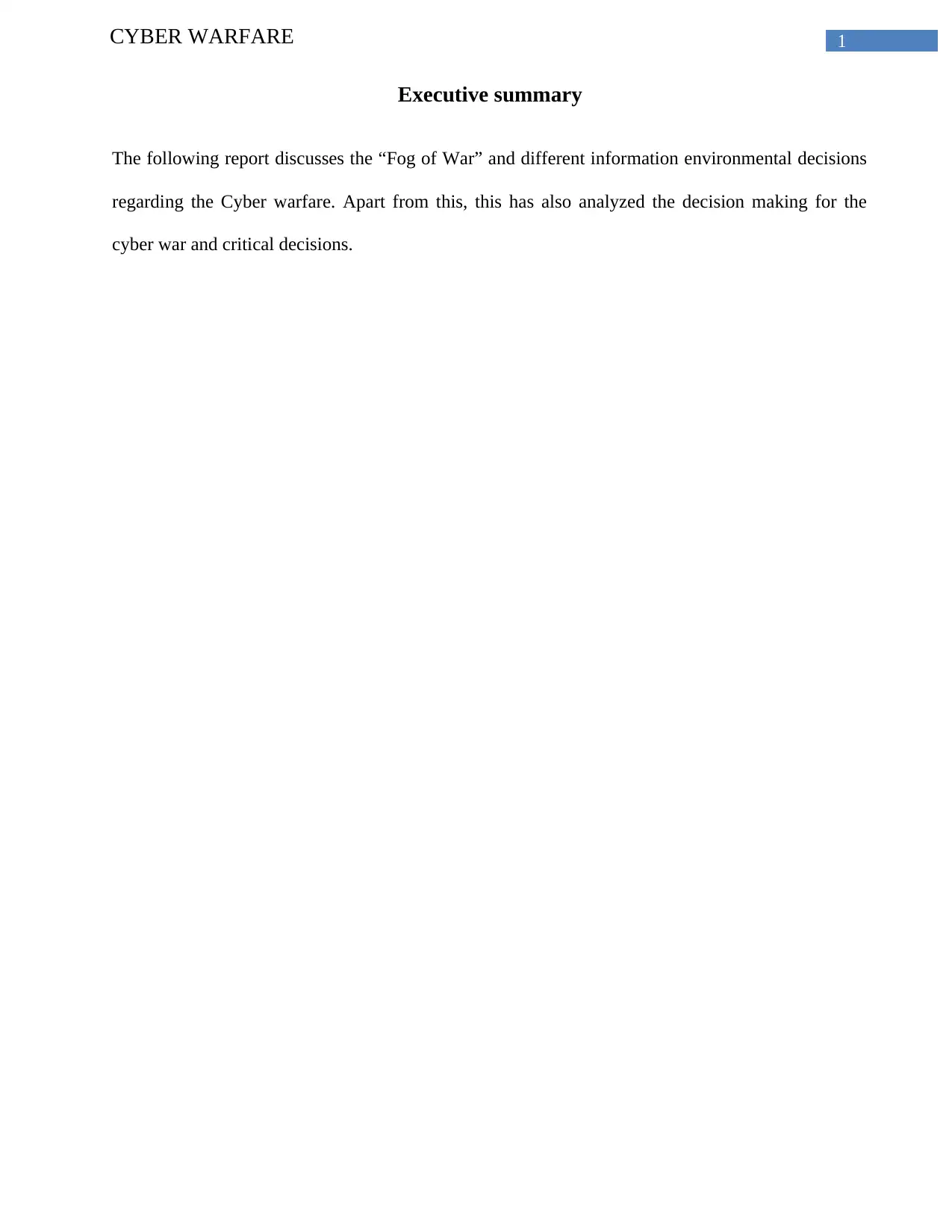
1CYBER WARFARE
Executive summary
The following report discusses the “Fog of War” and different information environmental decisions
regarding the Cyber warfare. Apart from this, this has also analyzed the decision making for the
cyber war and critical decisions.
Executive summary
The following report discusses the “Fog of War” and different information environmental decisions
regarding the Cyber warfare. Apart from this, this has also analyzed the decision making for the
cyber war and critical decisions.
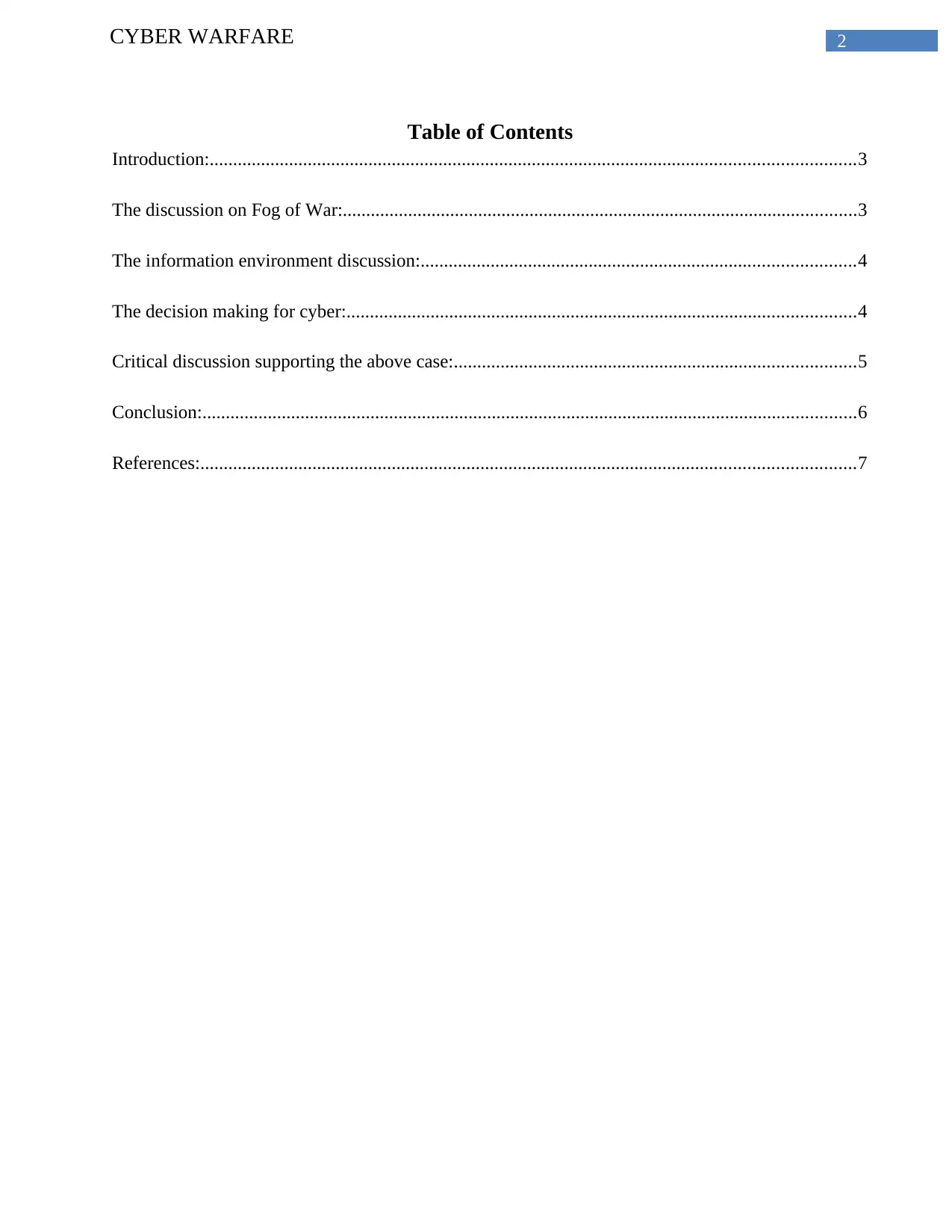
2CYBER WARFARE
Table of Contents
Introduction:..........................................................................................................................................3
The discussion on Fog of War:..............................................................................................................3
The information environment discussion:.............................................................................................4
The decision making for cyber:.............................................................................................................4
Critical discussion supporting the above case:......................................................................................5
Conclusion:............................................................................................................................................6
References:............................................................................................................................................7
Table of Contents
Introduction:..........................................................................................................................................3
The discussion on Fog of War:..............................................................................................................3
The information environment discussion:.............................................................................................4
The decision making for cyber:.............................................................................................................4
Critical discussion supporting the above case:......................................................................................5
Conclusion:............................................................................................................................................6
References:............................................................................................................................................7
⊘ This is a preview!⊘
Do you want full access?
Subscribe today to unlock all pages.

Trusted by 1+ million students worldwide
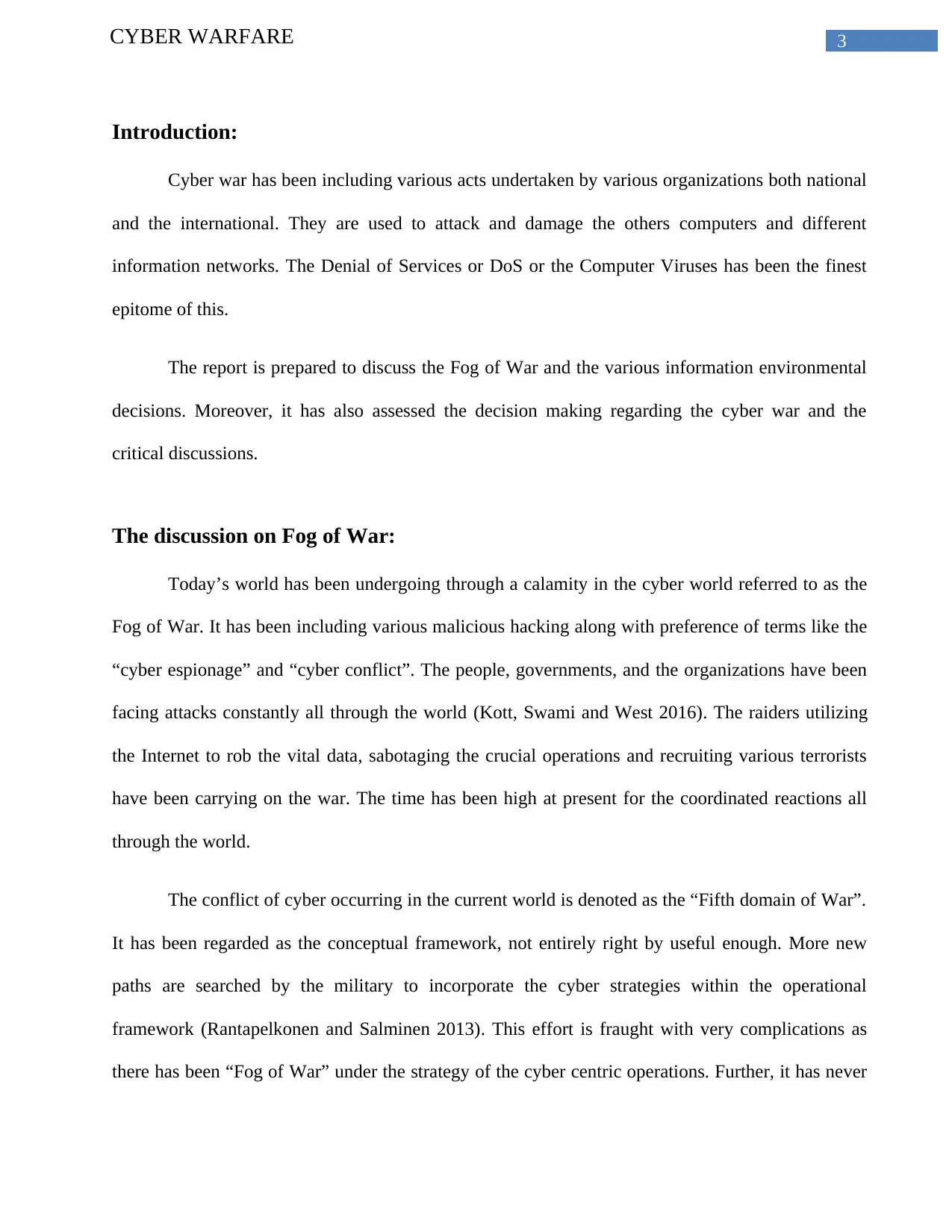
3CYBER WARFARE
Introduction:
Cyber war has been including various acts undertaken by various organizations both national
and the international. They are used to attack and damage the others computers and different
information networks. The Denial of Services or DoS or the Computer Viruses has been the finest
epitome of this.
The report is prepared to discuss the Fog of War and the various information environmental
decisions. Moreover, it has also assessed the decision making regarding the cyber war and the
critical discussions.
The discussion on Fog of War:
Today’s world has been undergoing through a calamity in the cyber world referred to as the
Fog of War. It has been including various malicious hacking along with preference of terms like the
“cyber espionage” and “cyber conflict”. The people, governments, and the organizations have been
facing attacks constantly all through the world (Kott, Swami and West 2016). The raiders utilizing
the Internet to rob the vital data, sabotaging the crucial operations and recruiting various terrorists
have been carrying on the war. The time has been high at present for the coordinated reactions all
through the world.
The conflict of cyber occurring in the current world is denoted as the “Fifth domain of War”.
It has been regarded as the conceptual framework, not entirely right by useful enough. More new
paths are searched by the military to incorporate the cyber strategies within the operational
framework (Rantapelkonen and Salminen 2013). This effort is fraught with very complications as
there has been “Fog of War” under the strategy of the cyber centric operations. Further, it has never
Introduction:
Cyber war has been including various acts undertaken by various organizations both national
and the international. They are used to attack and damage the others computers and different
information networks. The Denial of Services or DoS or the Computer Viruses has been the finest
epitome of this.
The report is prepared to discuss the Fog of War and the various information environmental
decisions. Moreover, it has also assessed the decision making regarding the cyber war and the
critical discussions.
The discussion on Fog of War:
Today’s world has been undergoing through a calamity in the cyber world referred to as the
Fog of War. It has been including various malicious hacking along with preference of terms like the
“cyber espionage” and “cyber conflict”. The people, governments, and the organizations have been
facing attacks constantly all through the world (Kott, Swami and West 2016). The raiders utilizing
the Internet to rob the vital data, sabotaging the crucial operations and recruiting various terrorists
have been carrying on the war. The time has been high at present for the coordinated reactions all
through the world.
The conflict of cyber occurring in the current world is denoted as the “Fifth domain of War”.
It has been regarded as the conceptual framework, not entirely right by useful enough. More new
paths are searched by the military to incorporate the cyber strategies within the operational
framework (Rantapelkonen and Salminen 2013). This effort is fraught with very complications as
there has been “Fog of War” under the strategy of the cyber centric operations. Further, it has never
Paraphrase This Document
Need a fresh take? Get an instant paraphrase of this document with our AI Paraphraser
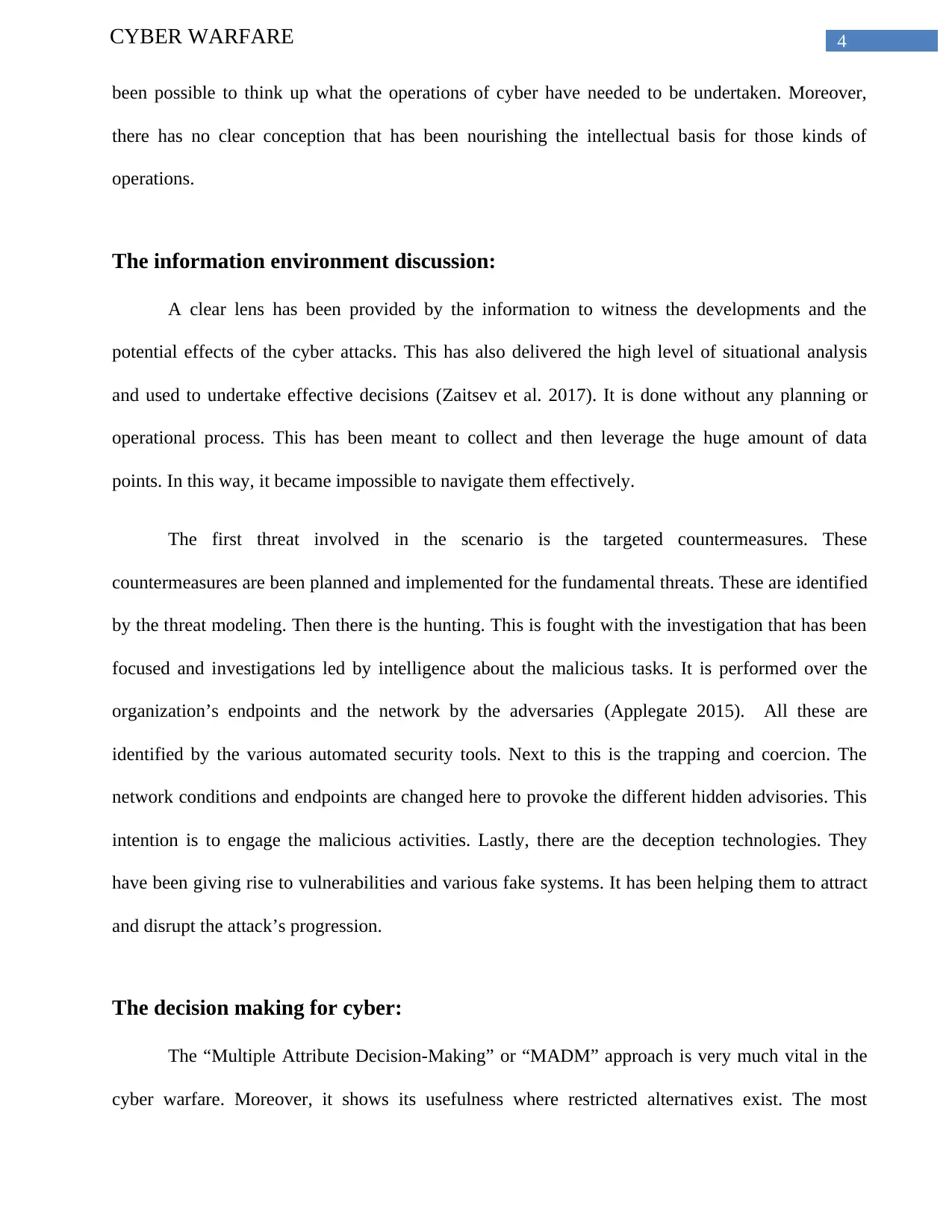
4CYBER WARFARE
been possible to think up what the operations of cyber have needed to be undertaken. Moreover,
there has no clear conception that has been nourishing the intellectual basis for those kinds of
operations.
The information environment discussion:
A clear lens has been provided by the information to witness the developments and the
potential effects of the cyber attacks. This has also delivered the high level of situational analysis
and used to undertake effective decisions (Zaitsev et al. 2017). It is done without any planning or
operational process. This has been meant to collect and then leverage the huge amount of data
points. In this way, it became impossible to navigate them effectively.
The first threat involved in the scenario is the targeted countermeasures. These
countermeasures are been planned and implemented for the fundamental threats. These are identified
by the threat modeling. Then there is the hunting. This is fought with the investigation that has been
focused and investigations led by intelligence about the malicious tasks. It is performed over the
organization’s endpoints and the network by the adversaries (Applegate 2015). All these are
identified by the various automated security tools. Next to this is the trapping and coercion. The
network conditions and endpoints are changed here to provoke the different hidden advisories. This
intention is to engage the malicious activities. Lastly, there are the deception technologies. They
have been giving rise to vulnerabilities and various fake systems. It has been helping them to attract
and disrupt the attack’s progression.
The decision making for cyber:
The “Multiple Attribute Decision-Making” or “MADM” approach is very much vital in the
cyber warfare. Moreover, it shows its usefulness where restricted alternatives exist. The most
been possible to think up what the operations of cyber have needed to be undertaken. Moreover,
there has no clear conception that has been nourishing the intellectual basis for those kinds of
operations.
The information environment discussion:
A clear lens has been provided by the information to witness the developments and the
potential effects of the cyber attacks. This has also delivered the high level of situational analysis
and used to undertake effective decisions (Zaitsev et al. 2017). It is done without any planning or
operational process. This has been meant to collect and then leverage the huge amount of data
points. In this way, it became impossible to navigate them effectively.
The first threat involved in the scenario is the targeted countermeasures. These
countermeasures are been planned and implemented for the fundamental threats. These are identified
by the threat modeling. Then there is the hunting. This is fought with the investigation that has been
focused and investigations led by intelligence about the malicious tasks. It is performed over the
organization’s endpoints and the network by the adversaries (Applegate 2015). All these are
identified by the various automated security tools. Next to this is the trapping and coercion. The
network conditions and endpoints are changed here to provoke the different hidden advisories. This
intention is to engage the malicious activities. Lastly, there are the deception technologies. They
have been giving rise to vulnerabilities and various fake systems. It has been helping them to attract
and disrupt the attack’s progression.
The decision making for cyber:
The “Multiple Attribute Decision-Making” or “MADM” approach is very much vital in the
cyber warfare. Moreover, it shows its usefulness where restricted alternatives exist. The most
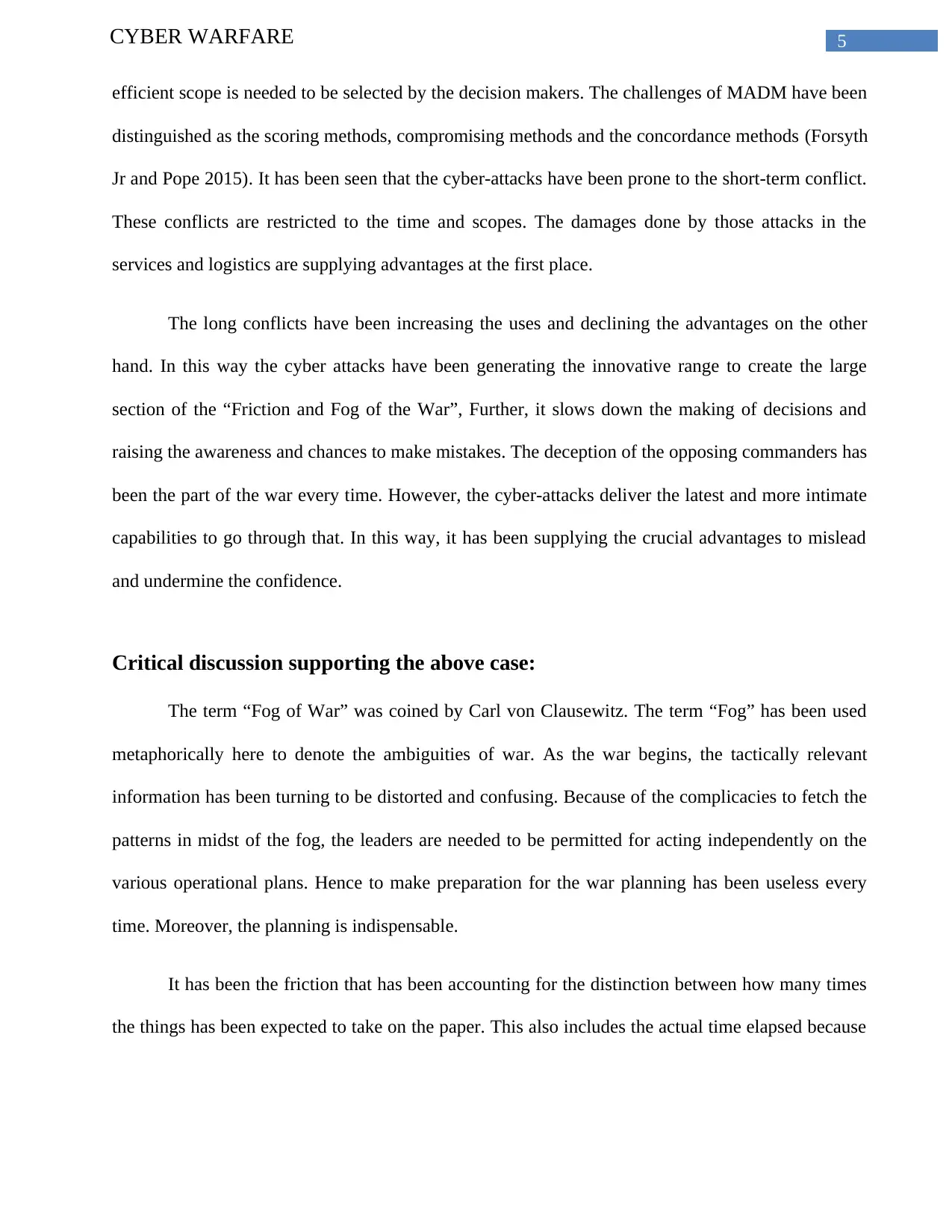
5CYBER WARFARE
efficient scope is needed to be selected by the decision makers. The challenges of MADM have been
distinguished as the scoring methods, compromising methods and the concordance methods (Forsyth
Jr and Pope 2015). It has been seen that the cyber-attacks have been prone to the short-term conflict.
These conflicts are restricted to the time and scopes. The damages done by those attacks in the
services and logistics are supplying advantages at the first place.
The long conflicts have been increasing the uses and declining the advantages on the other
hand. In this way the cyber attacks have been generating the innovative range to create the large
section of the “Friction and Fog of the War”, Further, it slows down the making of decisions and
raising the awareness and chances to make mistakes. The deception of the opposing commanders has
been the part of the war every time. However, the cyber-attacks deliver the latest and more intimate
capabilities to go through that. In this way, it has been supplying the crucial advantages to mislead
and undermine the confidence.
Critical discussion supporting the above case:
The term “Fog of War” was coined by Carl von Clausewitz. The term “Fog” has been used
metaphorically here to denote the ambiguities of war. As the war begins, the tactically relevant
information has been turning to be distorted and confusing. Because of the complicacies to fetch the
patterns in midst of the fog, the leaders are needed to be permitted for acting independently on the
various operational plans. Hence to make preparation for the war planning has been useless every
time. Moreover, the planning is indispensable.
It has been the friction that has been accounting for the distinction between how many times
the things has been expected to take on the paper. This also includes the actual time elapsed because
efficient scope is needed to be selected by the decision makers. The challenges of MADM have been
distinguished as the scoring methods, compromising methods and the concordance methods (Forsyth
Jr and Pope 2015). It has been seen that the cyber-attacks have been prone to the short-term conflict.
These conflicts are restricted to the time and scopes. The damages done by those attacks in the
services and logistics are supplying advantages at the first place.
The long conflicts have been increasing the uses and declining the advantages on the other
hand. In this way the cyber attacks have been generating the innovative range to create the large
section of the “Friction and Fog of the War”, Further, it slows down the making of decisions and
raising the awareness and chances to make mistakes. The deception of the opposing commanders has
been the part of the war every time. However, the cyber-attacks deliver the latest and more intimate
capabilities to go through that. In this way, it has been supplying the crucial advantages to mislead
and undermine the confidence.
Critical discussion supporting the above case:
The term “Fog of War” was coined by Carl von Clausewitz. The term “Fog” has been used
metaphorically here to denote the ambiguities of war. As the war begins, the tactically relevant
information has been turning to be distorted and confusing. Because of the complicacies to fetch the
patterns in midst of the fog, the leaders are needed to be permitted for acting independently on the
various operational plans. Hence to make preparation for the war planning has been useless every
time. Moreover, the planning is indispensable.
It has been the friction that has been accounting for the distinction between how many times
the things has been expected to take on the paper. This also includes the actual time elapsed because
⊘ This is a preview!⊘
Do you want full access?
Subscribe today to unlock all pages.

Trusted by 1+ million students worldwide
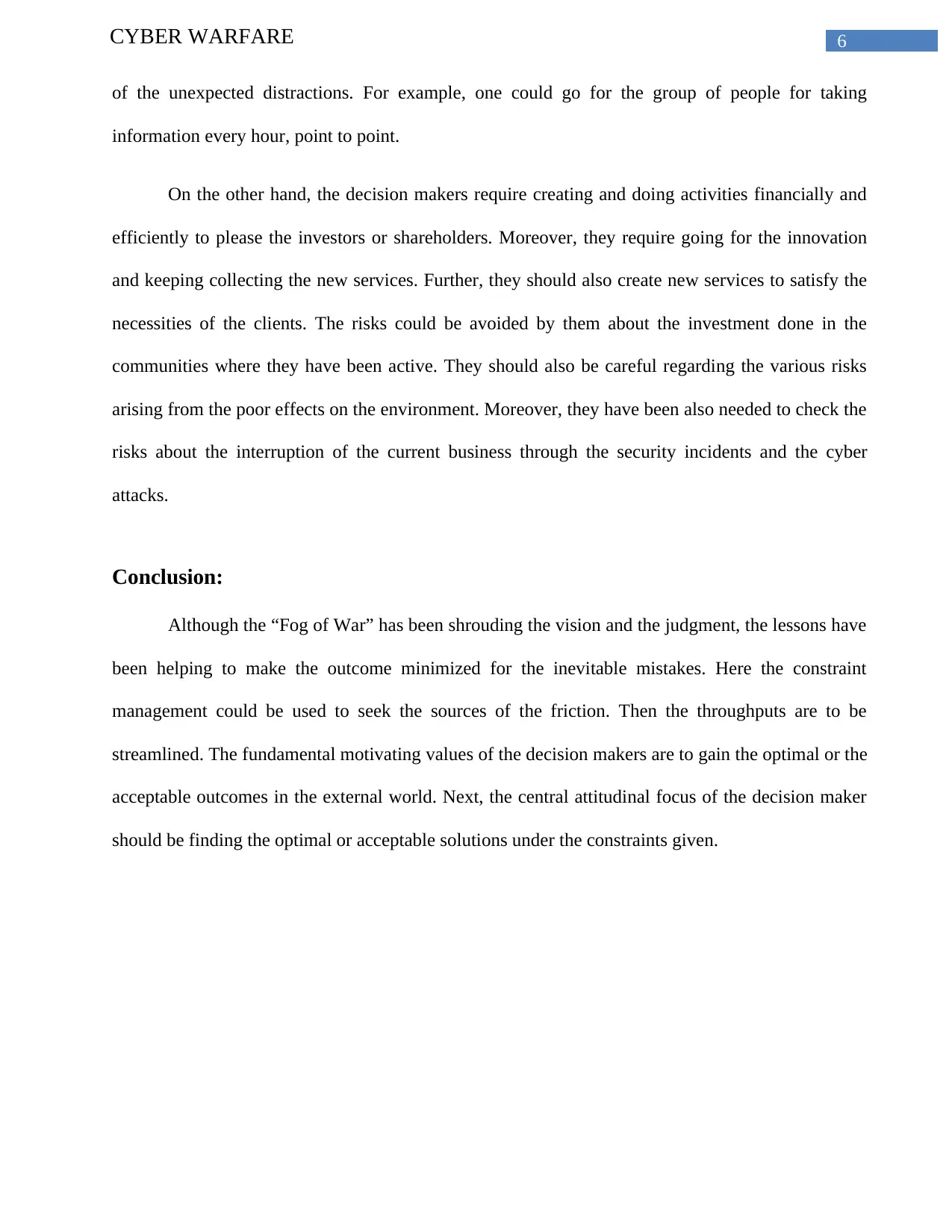
6CYBER WARFARE
of the unexpected distractions. For example, one could go for the group of people for taking
information every hour, point to point.
On the other hand, the decision makers require creating and doing activities financially and
efficiently to please the investors or shareholders. Moreover, they require going for the innovation
and keeping collecting the new services. Further, they should also create new services to satisfy the
necessities of the clients. The risks could be avoided by them about the investment done in the
communities where they have been active. They should also be careful regarding the various risks
arising from the poor effects on the environment. Moreover, they have been also needed to check the
risks about the interruption of the current business through the security incidents and the cyber
attacks.
Conclusion:
Although the “Fog of War” has been shrouding the vision and the judgment, the lessons have
been helping to make the outcome minimized for the inevitable mistakes. Here the constraint
management could be used to seek the sources of the friction. Then the throughputs are to be
streamlined. The fundamental motivating values of the decision makers are to gain the optimal or the
acceptable outcomes in the external world. Next, the central attitudinal focus of the decision maker
should be finding the optimal or acceptable solutions under the constraints given.
of the unexpected distractions. For example, one could go for the group of people for taking
information every hour, point to point.
On the other hand, the decision makers require creating and doing activities financially and
efficiently to please the investors or shareholders. Moreover, they require going for the innovation
and keeping collecting the new services. Further, they should also create new services to satisfy the
necessities of the clients. The risks could be avoided by them about the investment done in the
communities where they have been active. They should also be careful regarding the various risks
arising from the poor effects on the environment. Moreover, they have been also needed to check the
risks about the interruption of the current business through the security incidents and the cyber
attacks.
Conclusion:
Although the “Fog of War” has been shrouding the vision and the judgment, the lessons have
been helping to make the outcome minimized for the inevitable mistakes. Here the constraint
management could be used to seek the sources of the friction. Then the throughputs are to be
streamlined. The fundamental motivating values of the decision makers are to gain the optimal or the
acceptable outcomes in the external world. Next, the central attitudinal focus of the decision maker
should be finding the optimal or acceptable solutions under the constraints given.
Paraphrase This Document
Need a fresh take? Get an instant paraphrase of this document with our AI Paraphraser
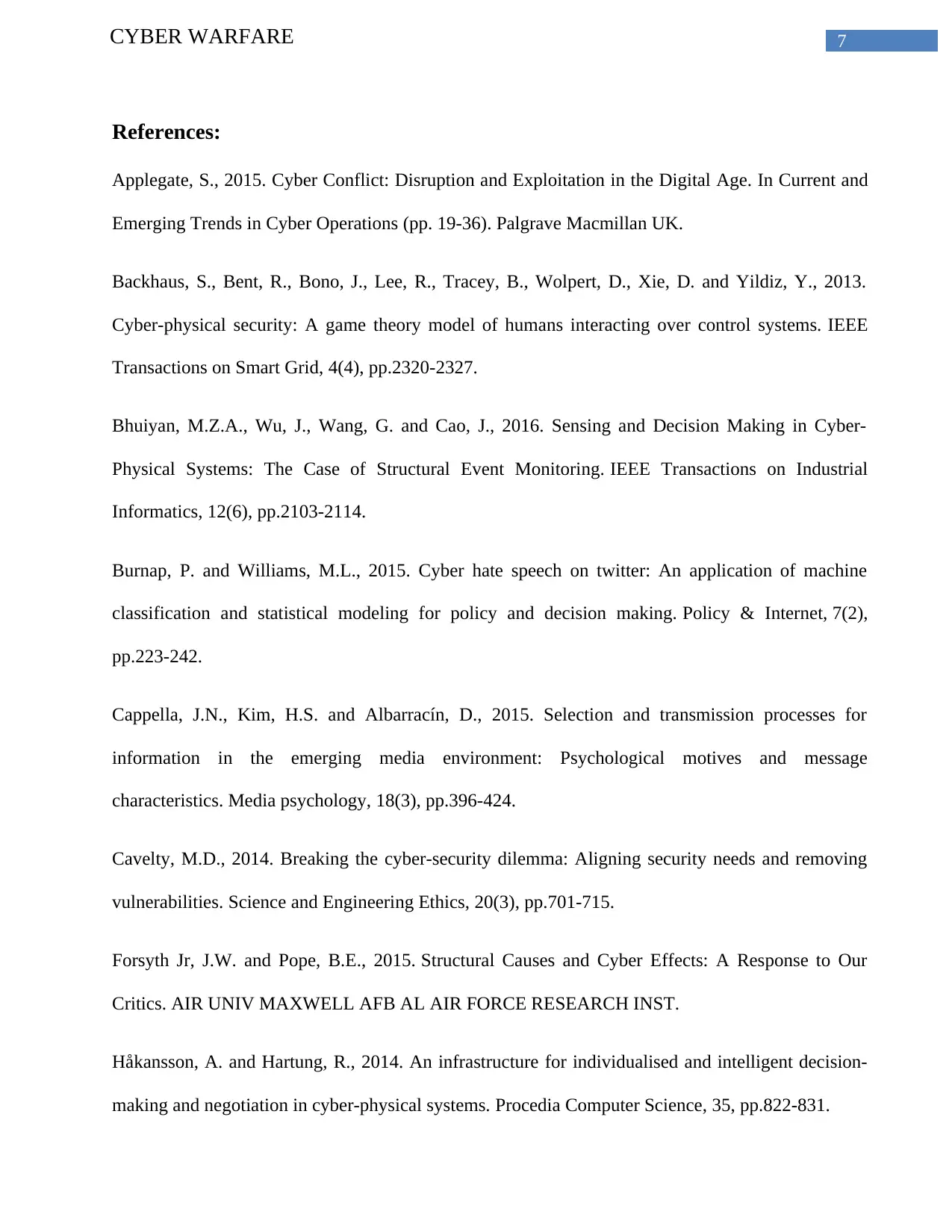
7CYBER WARFARE
References:
Applegate, S., 2015. Cyber Conflict: Disruption and Exploitation in the Digital Age. In Current and
Emerging Trends in Cyber Operations (pp. 19-36). Palgrave Macmillan UK.
Backhaus, S., Bent, R., Bono, J., Lee, R., Tracey, B., Wolpert, D., Xie, D. and Yildiz, Y., 2013.
Cyber-physical security: A game theory model of humans interacting over control systems. IEEE
Transactions on Smart Grid, 4(4), pp.2320-2327.
Bhuiyan, M.Z.A., Wu, J., Wang, G. and Cao, J., 2016. Sensing and Decision Making in Cyber-
Physical Systems: The Case of Structural Event Monitoring. IEEE Transactions on Industrial
Informatics, 12(6), pp.2103-2114.
Burnap, P. and Williams, M.L., 2015. Cyber hate speech on twitter: An application of machine
classification and statistical modeling for policy and decision making. Policy & Internet, 7(2),
pp.223-242.
Cappella, J.N., Kim, H.S. and Albarracín, D., 2015. Selection and transmission processes for
information in the emerging media environment: Psychological motives and message
characteristics. Media psychology, 18(3), pp.396-424.
Cavelty, M.D., 2014. Breaking the cyber-security dilemma: Aligning security needs and removing
vulnerabilities. Science and Engineering Ethics, 20(3), pp.701-715.
Forsyth Jr, J.W. and Pope, B.E., 2015. Structural Causes and Cyber Effects: A Response to Our
Critics. AIR UNIV MAXWELL AFB AL AIR FORCE RESEARCH INST.
Håkansson, A. and Hartung, R., 2014. An infrastructure for individualised and intelligent decision-
making and negotiation in cyber-physical systems. Procedia Computer Science, 35, pp.822-831.
References:
Applegate, S., 2015. Cyber Conflict: Disruption and Exploitation in the Digital Age. In Current and
Emerging Trends in Cyber Operations (pp. 19-36). Palgrave Macmillan UK.
Backhaus, S., Bent, R., Bono, J., Lee, R., Tracey, B., Wolpert, D., Xie, D. and Yildiz, Y., 2013.
Cyber-physical security: A game theory model of humans interacting over control systems. IEEE
Transactions on Smart Grid, 4(4), pp.2320-2327.
Bhuiyan, M.Z.A., Wu, J., Wang, G. and Cao, J., 2016. Sensing and Decision Making in Cyber-
Physical Systems: The Case of Structural Event Monitoring. IEEE Transactions on Industrial
Informatics, 12(6), pp.2103-2114.
Burnap, P. and Williams, M.L., 2015. Cyber hate speech on twitter: An application of machine
classification and statistical modeling for policy and decision making. Policy & Internet, 7(2),
pp.223-242.
Cappella, J.N., Kim, H.S. and Albarracín, D., 2015. Selection and transmission processes for
information in the emerging media environment: Psychological motives and message
characteristics. Media psychology, 18(3), pp.396-424.
Cavelty, M.D., 2014. Breaking the cyber-security dilemma: Aligning security needs and removing
vulnerabilities. Science and Engineering Ethics, 20(3), pp.701-715.
Forsyth Jr, J.W. and Pope, B.E., 2015. Structural Causes and Cyber Effects: A Response to Our
Critics. AIR UNIV MAXWELL AFB AL AIR FORCE RESEARCH INST.
Håkansson, A. and Hartung, R., 2014. An infrastructure for individualised and intelligent decision-
making and negotiation in cyber-physical systems. Procedia Computer Science, 35, pp.822-831.
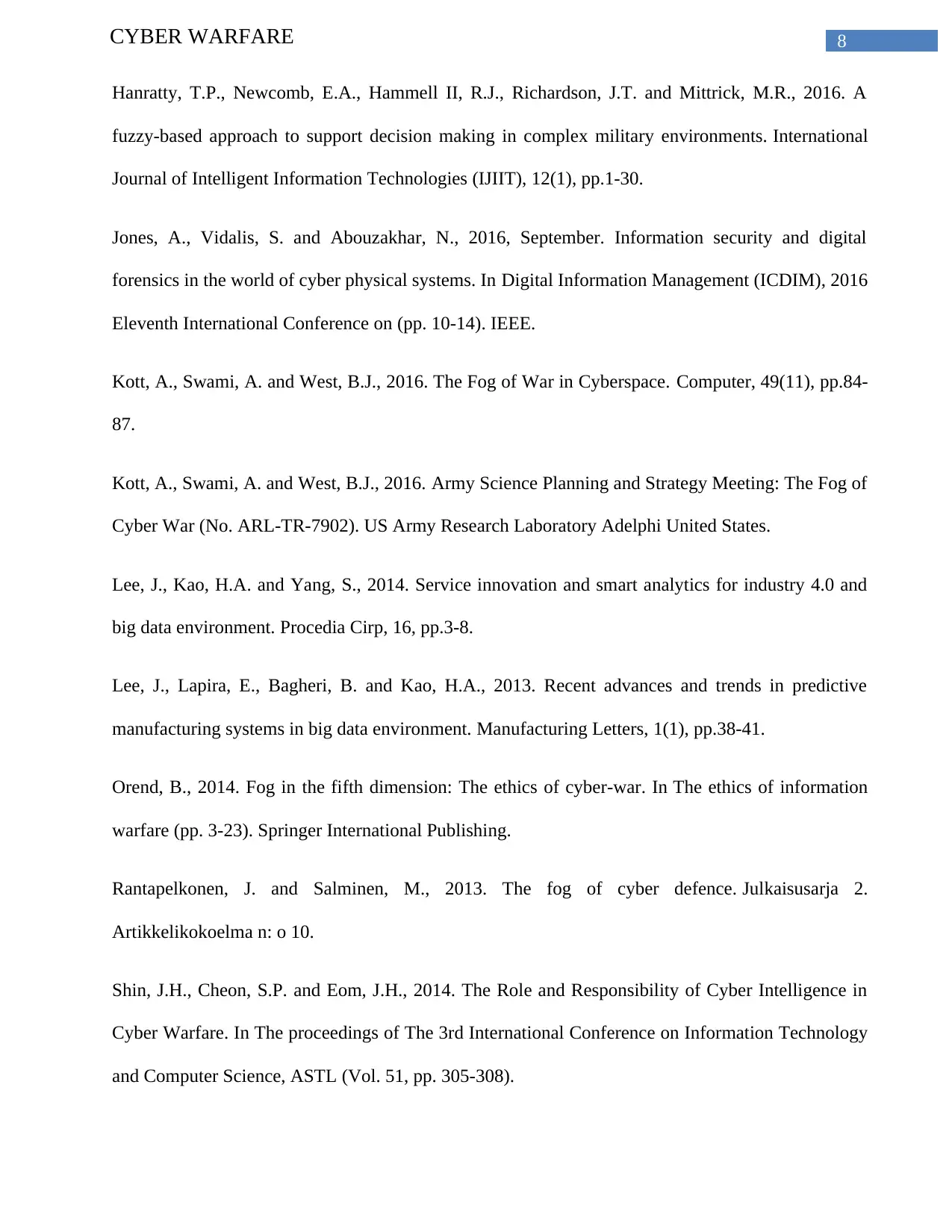
8CYBER WARFARE
Hanratty, T.P., Newcomb, E.A., Hammell II, R.J., Richardson, J.T. and Mittrick, M.R., 2016. A
fuzzy-based approach to support decision making in complex military environments. International
Journal of Intelligent Information Technologies (IJIIT), 12(1), pp.1-30.
Jones, A., Vidalis, S. and Abouzakhar, N., 2016, September. Information security and digital
forensics in the world of cyber physical systems. In Digital Information Management (ICDIM), 2016
Eleventh International Conference on (pp. 10-14). IEEE.
Kott, A., Swami, A. and West, B.J., 2016. The Fog of War in Cyberspace. Computer, 49(11), pp.84-
87.
Kott, A., Swami, A. and West, B.J., 2016. Army Science Planning and Strategy Meeting: The Fog of
Cyber War (No. ARL-TR-7902). US Army Research Laboratory Adelphi United States.
Lee, J., Kao, H.A. and Yang, S., 2014. Service innovation and smart analytics for industry 4.0 and
big data environment. Procedia Cirp, 16, pp.3-8.
Lee, J., Lapira, E., Bagheri, B. and Kao, H.A., 2013. Recent advances and trends in predictive
manufacturing systems in big data environment. Manufacturing Letters, 1(1), pp.38-41.
Orend, B., 2014. Fog in the fifth dimension: The ethics of cyber-war. In The ethics of information
warfare (pp. 3-23). Springer International Publishing.
Rantapelkonen, J. and Salminen, M., 2013. The fog of cyber defence. Julkaisusarja 2.
Artikkelikokoelma n: o 10.
Shin, J.H., Cheon, S.P. and Eom, J.H., 2014. The Role and Responsibility of Cyber Intelligence in
Cyber Warfare. In The proceedings of The 3rd International Conference on Information Technology
and Computer Science, ASTL (Vol. 51, pp. 305-308).
Hanratty, T.P., Newcomb, E.A., Hammell II, R.J., Richardson, J.T. and Mittrick, M.R., 2016. A
fuzzy-based approach to support decision making in complex military environments. International
Journal of Intelligent Information Technologies (IJIIT), 12(1), pp.1-30.
Jones, A., Vidalis, S. and Abouzakhar, N., 2016, September. Information security and digital
forensics in the world of cyber physical systems. In Digital Information Management (ICDIM), 2016
Eleventh International Conference on (pp. 10-14). IEEE.
Kott, A., Swami, A. and West, B.J., 2016. The Fog of War in Cyberspace. Computer, 49(11), pp.84-
87.
Kott, A., Swami, A. and West, B.J., 2016. Army Science Planning and Strategy Meeting: The Fog of
Cyber War (No. ARL-TR-7902). US Army Research Laboratory Adelphi United States.
Lee, J., Kao, H.A. and Yang, S., 2014. Service innovation and smart analytics for industry 4.0 and
big data environment. Procedia Cirp, 16, pp.3-8.
Lee, J., Lapira, E., Bagheri, B. and Kao, H.A., 2013. Recent advances and trends in predictive
manufacturing systems in big data environment. Manufacturing Letters, 1(1), pp.38-41.
Orend, B., 2014. Fog in the fifth dimension: The ethics of cyber-war. In The ethics of information
warfare (pp. 3-23). Springer International Publishing.
Rantapelkonen, J. and Salminen, M., 2013. The fog of cyber defence. Julkaisusarja 2.
Artikkelikokoelma n: o 10.
Shin, J.H., Cheon, S.P. and Eom, J.H., 2014. The Role and Responsibility of Cyber Intelligence in
Cyber Warfare. In The proceedings of The 3rd International Conference on Information Technology
and Computer Science, ASTL (Vol. 51, pp. 305-308).
⊘ This is a preview!⊘
Do you want full access?
Subscribe today to unlock all pages.

Trusted by 1+ million students worldwide
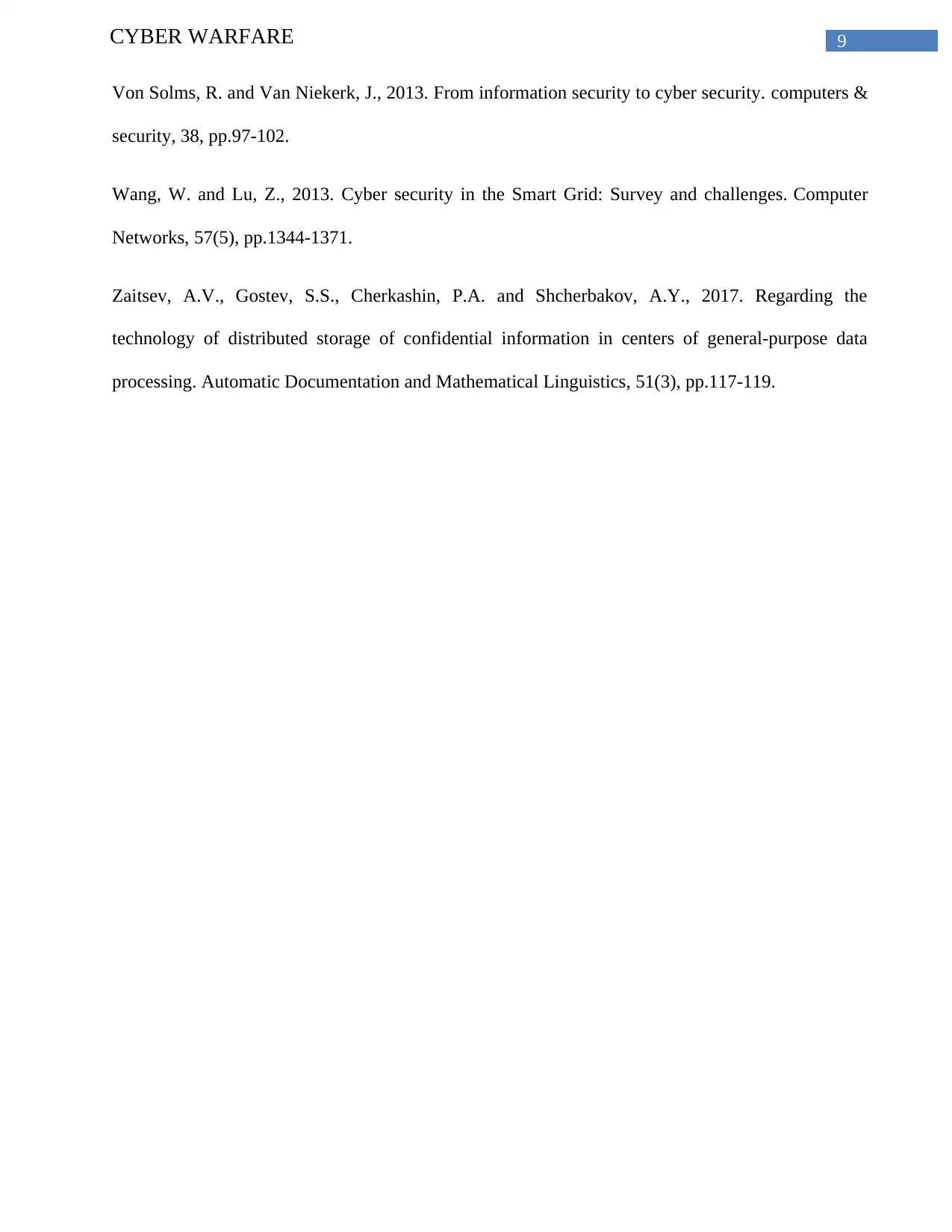
9CYBER WARFARE
Von Solms, R. and Van Niekerk, J., 2013. From information security to cyber security. computers &
security, 38, pp.97-102.
Wang, W. and Lu, Z., 2013. Cyber security in the Smart Grid: Survey and challenges. Computer
Networks, 57(5), pp.1344-1371.
Zaitsev, A.V., Gostev, S.S., Cherkashin, P.A. and Shcherbakov, A.Y., 2017. Regarding the
technology of distributed storage of confidential information in centers of general-purpose data
processing. Automatic Documentation and Mathematical Linguistics, 51(3), pp.117-119.
Von Solms, R. and Van Niekerk, J., 2013. From information security to cyber security. computers &
security, 38, pp.97-102.
Wang, W. and Lu, Z., 2013. Cyber security in the Smart Grid: Survey and challenges. Computer
Networks, 57(5), pp.1344-1371.
Zaitsev, A.V., Gostev, S.S., Cherkashin, P.A. and Shcherbakov, A.Y., 2017. Regarding the
technology of distributed storage of confidential information in centers of general-purpose data
processing. Automatic Documentation and Mathematical Linguistics, 51(3), pp.117-119.
1 out of 10
Related Documents
Your All-in-One AI-Powered Toolkit for Academic Success.
+13062052269
info@desklib.com
Available 24*7 on WhatsApp / Email
![[object Object]](/_next/static/media/star-bottom.7253800d.svg)
Unlock your academic potential
Copyright © 2020–2025 A2Z Services. All Rights Reserved. Developed and managed by ZUCOL.





